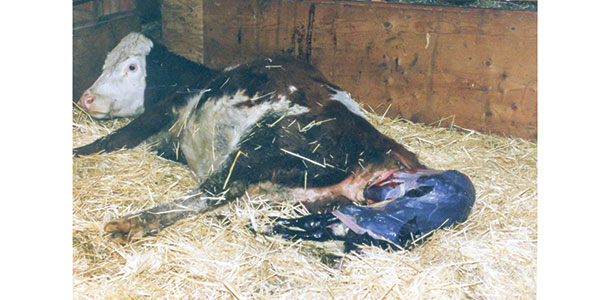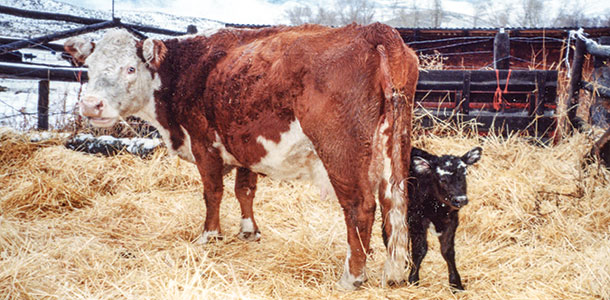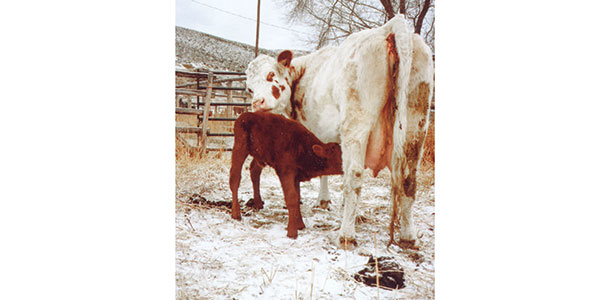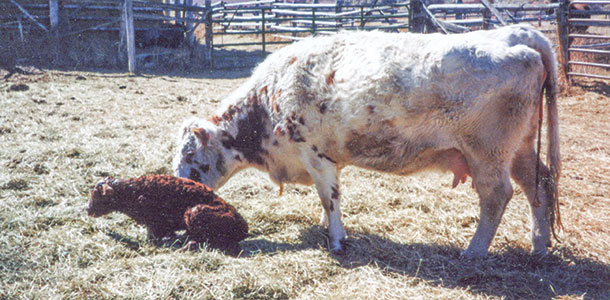Small calves chill faster in cold weather, and large calves may create calving difficulty.
Our perception of “normal” birthweight has changed over the years. “A crude estimate is that calf birthweight is about 7 percent of the dam’s mature weight, and this is why birthweights and dystocia rates increased when cattlemen pursued higher weaning weights and frame size,” he says.
 “Calf birthweight has been studied a lot. Genetics has the greatest influence, which is why genetic selection of bulls is so important for managing birthweight and why dystocia rates have dropped in the last 20 years,” Smith says.
“Calf birthweight has been studied a lot. Genetics has the greatest influence, which is why genetic selection of bulls is so important for managing birthweight and why dystocia rates have dropped in the last 20 years,” Smith says.
There are several variables that affect birthweight, including breed, genetics of sire and dam, length of gestation (heritable), age and size of dam, sex of calf, environmental factors, nutrition and health of the dam.
Bull calves, on average, tend to be larger than heifers because bovine males are larger than females and because male calves are often carried a few days longer than heifer calves of similar genetics; if a cow goes past her due date, she is likely to have a bull. If she calves a few days early, the calf is often a heifer.
“Today, with ultrasound pregnancy testing, we know the gender of the fetus, can be prepared for a larger bull calf and can also determine whether the cow is carrying twins.
Though twins tend to be smaller than singletons, they may still create dystocia because of abnormal presentation. If they come one at a time, they come easily, however, because of smaller size.
Gestation and feeding periods
Some breeds and family lines within breeds tend to have gestation lengths slightly shorter or longer than the average 283 days. Low-birthweight cattle often have shorter-than-average gestation, and high-birthweight cattle tend to have longer-than-average gestation.
The fetus is growing fastest in the final stages, so several more days’ gestation creates a larger calf. One study showed that each extra day of gestation amounts to at least 1 pound more in the size or weight of the calf.
 Kris Ringwall, Dickinson Research Extension Center, North Dakota State University, says that if a bull has genetics for high birthweight, it could be because his calves have a lot of late growth at the end of gestation, or longer gestation. “Sometimes unexpected things happens.
Kris Ringwall, Dickinson Research Extension Center, North Dakota State University, says that if a bull has genetics for high birthweight, it could be because his calves have a lot of late growth at the end of gestation, or longer gestation. “Sometimes unexpected things happens.
A producer might buy a low-birthweight bull and still get big calves.
Perhaps the combination of genetics of that set of cattle and that particular bull created larger calves. For some reason those cows or heifers are carrying calves a little longer, even though the bull had smaller birthweight.”
There’s always a genetic factor on the cow side, and some of this is not always known or well understood.
“Birthweight can be affected by changing the rate of fetal growth or by changing length of gestation,” Smith says. “Environmental factors affecting growth rate include nutrition of the dam and environmental temperature.
Overfeeding cows in late gestation increases risk for dystocia because of increased calf size and fat accumulation in the birth canal. Underfeeding to reduce birthweight is counterproductive, however, because of increased weakness and metabolic disease in underfed cows,” he says.
 Ken Olson, extension beef specialist, South Dakota State University, says some producers have tried underfeeding cows – to have smaller calves – but data shows they often increase calving difficulty. “You set yourself up to have a weak cow.
Ken Olson, extension beef specialist, South Dakota State University, says some producers have tried underfeeding cows – to have smaller calves – but data shows they often increase calving difficulty. “You set yourself up to have a weak cow.
The calf might be smaller, but her ability to push it out is less,” he explains.
“Even worse, the cow has poorer colostrum and won’t pass adequate immunity to the calf. You may have a weak calf that is slower to get up, slower to suckle, and when it finally does suckle, it gets inadequate colostrum.
Also the underfed cow is slow to return to estrus, with lower fertility,” Olson says.
The other extreme is overfeeding. This can happen when ranchers increase feed to help cows through cold weather. Extra fat in the birth canal leads to difficult calving, plus calves are slightly larger from overfeeding the cow and a cold winter.
During cold weather, cattle reduce heat loss by routing more blood around internal organs and less to the skin and extremities. This means there is more blood supply to the uterus and more nutrients channeled into growth of the calf, especially during the last trimester when the fetus is growing fastest.
Calves tend to be larger at birth when their dams have just gone through a cold winter. “Many producers have experienced this. Without a change in genetics, birthweights are a few pounds higher after a colder winter,” says Olson.
Summer-born calves are generally a little smaller than winter-born calves. “Summer or fall calving can be a dream (regarding fewer calving problems) compared to late winter and early spring calving,” Olson says.

“Many things can contribute to dystocia, and it’s usually a combination of factors that impact calving season. With all the emphasis today on lowering birthweights, especially in the two Angus breeds, the primary thing we have changed genetically is gestation length,” he says.
“Most producers with Angus cows realize that now they can expect calves as much as 14 days sooner than we did earlier, based on a 283-day gestation,” Olson says.
Producers in the Charolais breed who were struggling with huge calves and dystocia 50 years ago were able to change this by selecting genetics with shorter gestation. If both the sire and dam are programmed for shorter gestation, calves will be smaller.
Recording your inputs
Ringwall says that if calves are on the heavy side, the best thing to do is “crank down harder on EPDs in selecting low-birthweight bulls. We can’t predict weather and don’t want to short-change cows on nutrition, but we can select for lower birthweight.”

Good herd records are important. “If you know the genetics for size and calf conformation, you have an idea which cows and bulls might produce easily born calves or a difficult birth,” Olson says.
“If a big calf has a relatively small head and narrow shoulders, it can usually be born more readily than a smaller calf with wider head or shoulders. This was one of the things that made Salers popular in the 1990s. Those calves could weigh as much as calves of other breeds and were born easier because they were more streamlined.” Birthweight isn’t the only factor in calving ease.

“Herd records are important because the cow provides half of those genetics. If you know which cows in your herd have historically thrown big calves, you know which ones to pay closer attention to during calving season,” Olson says. Even if you use a low-birthweight bull, if the calf throws back to the dam’s side for birth weight or gestation length, you’ll still have a big calf.
“In our herd at the SDSU Antelope research station, a few cows always throw a big calf, no matter which bull you use. Those cows have calves that weigh about 100 pounds, and you know you may have to help them,” he says.
“Use those records in replacement heifer selection. Don’t keep heifers from a cow that always throws 100-pound calves. No matter what that daughter looks like – big and beautiful – don’t keep her for a cow,” Olson says.

Ringwall says producers want to push growth and have low birthweights at the same time. “The great thing about genetics today is we can do that. Most breeds have held birthweights down and increased growth. It can be done; we just need to select for these traits.
That’s not to say we won’t occasionally have a malpresented calf, but even the malpresented calf is generally a function of birthweight (more difficult to get into position for birth). But if we control birthweight and feed cows right, problems should be minimal.” ![]()
Heather Thomas is a freelance writer based in Idaho.
PHOTOS
PHOTO 1: If calves are large at birth, the cow or heifer may need assistance.
PHOTO 2: David R. Smith
PHOTO 3: Kris Ringwall
PHOTO 4: Ken Olson
PHOTO 5: This heifer just gave birth quickly and easily.
PHOTOS 6-8: The goal is to have birthweight low enough for easy birth, so the calf will be quick to get up and start nursing. Photos by Heather Smith Thomas.







